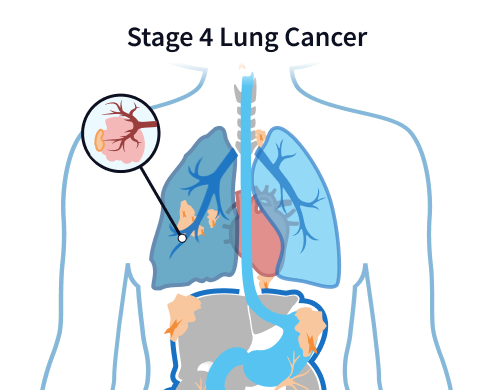Stage 4 Lung Cancer
Stage 4 lung cancer is the most advanced stage, usually spreading to multiple areas of the body. Symptoms include persistent cough, chest pain and weight loss. Smoking and asbestos exposure are common risk factors. Treatment aims to extend life and ease symptoms with chemo, immunotherapy and palliative care.

What Is Stage 4 Lung Cancer?
Stage 4 lung cancer is the most advanced form of the disease because it has spread beyond the lungs to other organs such as the brain, liver or bones. This stage is also known as metastatic lung cancer. Asbestos exposure is a recognized risk factor for lung cancer.
Key Facts About Stage 4 Lung Cancer
- Stage 4 lung cancer means cancer has spread beyond the lungs.
- Asbestos exposure can contribute to lung cancer development.
- Treatments focus on symptom relief and life extension.
Lung cancer risk is especially high in individuals who work with or near asbestos-containing materials. While pleural mesothelioma is the cancer most strongly linked to asbestos, exposure can also contribute to the development of non-small cell and small cell lung cancers.
Types of Stage 4 Lung Cancer
Lung cancer is classified by cell type, which affects its growth, treatment response and metastasis or spread. The two primary types of stage 4 lung cancer are non-small cell and small cell.
Non-Small Cell Lung Cancer
NSCLC accounts for about 80% to 85% of all lung cancers, according to the American Lung Association. It typically spreads slower than small-cell lung cancer. But by stage 4, it has reached distant organs. Its survival rates are higher than small cell lung cancer. Treatment options include chemotherapy, immunotherapy, targeted therapy, surgery and/or radiation.
Small Cell Lung Cancer
SCLC is more aggressive and often reaches stage 4 quickly. This type is strongly associated with smoking but can also develop because of asbestos exposure. Roughly 15% of lung cancers involve small cells. More than 65% of SCLC patients have late-stage disease at diagnosis.
Asbestos-Related Lung Cancer
Asbestos exposure increases the risk of lung cancer, especially in people with prolonged exposure. This type of lung cancer often presents decades after initial exposure and may be mistaken for mesothelioma.
Symptoms of Stage 4 Lung Cancer
By the time lung cancer reaches stage 4, symptoms such as pain and fatigue are usually severe and may significantly impact daily life. These symptoms overlap with mesothelioma, making an accurate diagnosis essential for those with a history of asbestos exposure.
Common Symptoms of Stage 4 Lung Cancer
- Bone pain
- Chest pain
- Coughing up blood
- Fatigue
- Hoarseness
- Persistent cough
- Shortness of breath
- Unexplained weight loss
Dr. Snehal Smart, a Patient Advocate at The Mesothelioma Center, says that although symptoms may be severe in stage 4, treatment options are available. “Most patients I speak with have received a stage 4 diagnosis. It doesn’t necessarily mean the end stages of life,” Snehal said. “Many patients can still prolong survival time with clinical trials, immunotherapy and chemotherapy.”

Get help paying for treatment and other expenses by accessing trust funds, grants and other options.
Access Funds NowHow Is Stage 4 Lung Cancer Diagnosed?
Diagnosing stage 4 lung cancer typically involves multiple tests. These tests can confirm the presence of cancer and determine how far it has spread.
Steps to a Stage 4 Lung Cancer Diagnosis
- Medical History & Physical Exam: Doctors assess risk factors such as smoking and asbestos exposure.
- Imaging Tests: CT and PET scans help identify tumors and metastatic spread.
- Blood Tests: May provide additional information on cancer progression.
- Biopsy: A tissue sample confirms the type of lung cancer.
Mesothelioma is diagnosed using similar methods. This underscores the importance of distinguishing between asbestos-related lung cancer and mesothelioma.
Stage 4 Lung Cancer Staging
Stage 4 lung cancer is further divided into stages 4a and 4b using the Tumor Node Metastasis system. TNM measures tumor size, lymph node involvement and metastasis.
Stage 4a indicates cancer has spread to pleural fluid around the lungs, the lymph nodes and to one place in organs like the brain, bones or liver. Stage 4b indicates malignant tumors have spread to distant lymph nodes and multiple places in other organs.
Non-small cell lung cancer spreads to the brain in about 47% of patients. It can also spread to the bones (36%), liver (22%), adrenal glands (15%), thoracic cavity (11%) and distant lymph nodes (10%), according to BMC Cancer.
Treatment Options for Stage 4 Lung Cancer
While there is no cure for stage 4 lung cancer, treatment aims to extend survival and manage symptoms. Several treatment options can improve patients’ well-being. An asbestos cancer specialist can integrate palliative care early and significantly improve a patient’s comfort and well-being.
Treatments for Stage 4 Lung Cancer
- Chemotherapy: Slows tumor growth and relieves symptoms.
- Immunotherapy: Helps the immune system fight cancer cells.
- Palliative Care: Focuses on symptom relief and quality of life.
- Radiation Therapy: Reduces pain and tumor size.
- Targeted Therapy: Blocks specific cancer cell biomarker mutations.
Treatment for lung cancer caused by asbestos exposure may differ. These tumors often develop alongside scarring in the lungs from asbestosis.
Managing Symptoms and Quality of Life
Types of Symptom Management
Work with your doctor to find the right pain relief plan, including opioids, nerve blocks or anti-inflammatory medications. Use heat or cold therapy to alleviate muscle aches and joint pain. Try relaxation techniques like deep breathing and guided imagery to reduce stress-related pain.
Approaches for Managing Symptoms
- Breathing Support: Oxygen therapy and pulmonary rehabilitation.
- Nutritional Support: Maintaining strength through a balanced diet.
- Pain Management: Medications and nerve-blocking procedures.
Use a fan or cool air directed at the face to ease shortness of breath. Practice pursed-lip breathing to slow breathing and improve oxygen flow. Engage in light physical activity, like stretching or walking, to strengthen lung capacity without overexertion.

Eating the right diet throughout mesothelioma treatment can ease your symptoms.
Get Free Recipes and TipsHow Long Can You Live With Stage 4 Lung Cancer?
Stage 4 lung cancer patients, whether or not they were exposed to asbestos, typically survive 6.3 months to 11.4 months. This varies by cell type and treatment response. Some patients live longer with effective treatment. Notably, lung cancer is the most common and deadliest cancer in the U.S. among men and women.
Stage 4 Lung Cancer 5-Year Survival Rates by Type
- Non-Small Cell Lung Cancer: Approximately 7% of stage 4 non-small cell lung cancer patients survive 5 years from the time of their diagnosis, according to the National Cancer Institute’s SEER database.
- Small Cell Lung Cancer: Approximately 3% of distant-stage small cell lung cancer patients survive 5 years from the time of their diagnosis.
The prognosis for stage 4 lung cancer depends on multiple factors, including overall health, treatment response and whether the cancer is NSCLC or SCLC. Survival rates are only estimates, and each person has a unique response to treatments. Clinical trials for new treatments like genetic and immunotherapy are continuously improving stage 4 lung cancer survival rates.
Life Expectancy Without Treatment
On average, non-small cell lung cancer patients survive about 7 months, while small cell lung cancer patients survive 2 to 4 months without treatment. Life expectancy for lung cancer from asbestos exposure is similar to that from smoking or radon.
Palliative care can improve comfort and extend life. Many patients choose to avoid treatment, fearing side effects or reduced quality of life. Unfortunately, late-stage lung cancer prognosis is often poor for those who don’t pursue treatment. Remember that treatment slows the spread of cancer. Without it, the cancer continues to spread uncontrolled.
Common Questions About Stage 4 Lung Cancer
- Is stage 4 lung cancer curable?
-
There is no cure for stage 4 lung cancer, but treatments can extend life and improve the quality of life. Some patients experience long-term survival with newer therapies.
- What makes stage 4 lung cancer different from earlier stages?
-
At stage 4, the cancer has metastasized beyond the lungs. That makes treatment more complex. Treatment is more successful in the earlier stages of lung cancer.
- Can asbestos exposure cause stage 4 lung cancer?
-
Yes, long-term asbestos exposure is a known cause of lung cancer. Individuals exposed to asbestos should undergo regular checkups. Patients may also be eligible for legal compensation.
- Are clinical trials available for stage 4 lung cancer?
-
Ongoing clinical trials are testing new stage 4 lung cancer treatments, including immunotherapy and targeted therapies.



